“Norwegians should find themselves in less oil and more art”
Interview with art collector and critic Danby Choi
Danby Choi perceived art as straight up boring, when he was a kid. But somehow, down the line, this changed drastically. Today, he enjoys the daily pleasure of art as an art collector – in addition to his job as editor and publisher of the Norwegian critical cultural magazine Subjekt and art critic at the national newspaper Aftenposten. Determined to raise the public’s awareness on art and its value to the society at large, he is way beyond ‘stage boring’. Life has its mysterious ways… this interview provides a glimpse into the life and art collection of Danby Choi.
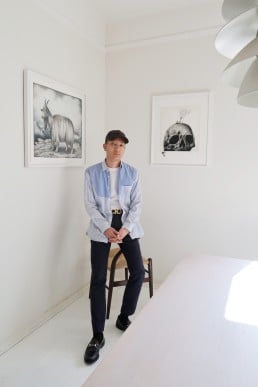
Name: Danby Choi
Location: Torshov, Oslo
Started collecting in year: 2011
Number of artworks in collection: 10
Name of collection: Danby’s
What is your earliest memory of art, and what led you to start collecting it?
Looking back at my childhood, I remember art as boring — something forced on me by school and parents. I haven’t really been that interested in arts before recently, maybe the three last years, as I have gotten more and more interested in aesthetics in general. But the story of how I started collecting art is as simple as … As an 18 years old, I moved out and needed to decorate the walls of my new place. I used to be a rebellious anti-everything, and identified with the Norwegian pop-artist Pushwagner’s take on capitalism, working classes, and consumerism. My first piece, «Sitting Down» (2010) by Pushwagner shows up to hundred blonde men in pink suits sitting down at their office desks preparing to take orders. I bought it in 2012, and I liked to look at the print and think «I will not become any of those». Lol! It satisfied all that I needed: It was affordable, big in format, colourful, decorative, and easy to consume. It is absolutely not my proudest piece today, but close to nothing from my days as an 18-year-old is. At least it gave me a lust for collecting more art, also the worth of it has doubled since I bought it seven years ago. All these aspects, that are even hardly possible to discuss in rational ways, interest me a lot.
What is it about art that appeals to you?
I like to look at it this way: First and foremost, I am a writer. And as a writer, I find art as the most challenging subject to write about. Not because of its rich theory and history, that is arguably less interesting than … geography, even. But all these genuine, free expressions. Critical thinking. Immateriality. Discipline and talent. Colors. All these things that make art so interesting to write about, when it at the same time seems so pointless to do it. Writing is about putting information and thoughts in order. With art, this can seem hopeless. And that’s exactly why it is so appealing as well. What you think and the information you receive from an art piece is neither maths, theory or facts, it is aesthetical expressions and ethical emotions. As I like to say to our new contributors in Subjekt, that’s why you can’t be wrong in what you experience in meetings with art. But when you review it, like anything, your argumentations should be bulletproof. The trench between good art and good critic is terrible, so it’s really a challenge which I find appealing.
How would you describe yourself as an art collector?
I have never described myself as an art collector, because I feel the «collecting» part has so much to do with making smart choices about buying art. I mean «the collected art» should be an investment, bought cheap, sold expensive, and also it should have a thematic context, et cetera. Well, I haven’t thought about that, neither on a curatorial level. I buy art to decorate my living space a bit randomly according to which artist I think is interesting at the time that I am buying from them.
What is the main motivation behind your collecting?
Definitely to decorate the walls with something meaningful.
Describe your collection in three words.
New, Norwegian… Nice.
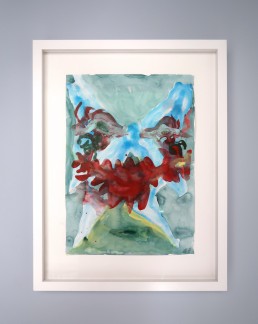
Is there any particular type of art that appeals to you or anything that unites all the works in your collection?
No. Except for the fact that they represent my constantly changing taste. They are also all Norwegian, as the Norwegian art scene is what I find most interesting. But not on purpose, for the collection’s cause.
How important is it for you to meet the artist behind the artwork?
Actually not that important, it can both give and take away from your experience with the art. I like to watch art pieces that are not explained. As an art critic, this is also a key principle for me.
What is the most recent piece of art you added to your collection and why?
Christian Tony Norum’s «Chateau de Lyon» (2015). I look at it and think: Am I a genius or an idiot for finding this piece so appealing?
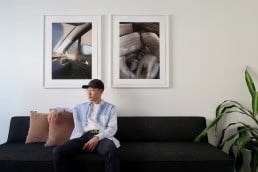
Has digitalization changed the way you collect art?
Yes, in a good way. My latest pieces were first found at QB Gallery’s online shop, before I went there to finally buy it.
What or who has influenced you as a collector?
The art and the artists, really. I cannot credit anyone for making me interested in Norwegian contemporary art, as I always thought they explained it for me in such a bad way. I’d rather say I was curious about what these some-thousand Norwegians were so interested in about aesthetics.
Is there any specific place you always return to when you need an art fix?
Well, if I need artistic inspiration or motivation, I check our art editor Una Mathiesen Gjerde’s guide on exhibition openings in Oslo the same week. Oslo is a fantastic city for arts, with several good exhibition openings every week. We are lucky!
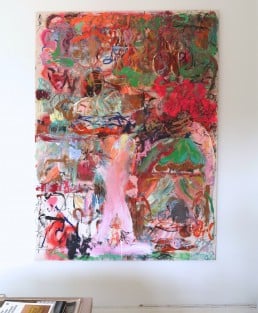
The art market has a reputation of being a playground for the elite. What is your experience of this?
The market is, of course. By looking at who they really are, the collectors, till now, in the big picture. But I guess a key principle for Artland is to do something about this by also showing that it’s not. And I guess we are on a bettering way, and I am happy for that, as democratizing the arts is really a key principle for me also.
Why?
Making arts and culture more available for the people has been a bipartisan cultural political goal in Norway since the 50’s. I would love a society where the people in a bigger manner discussed arts and immaterial culture, rather than the opposite. We can’t afford it. Norwegians will have to find themselves in less oil and more art. Less material consume and more cultural experiences. Norway’s cultural life is great, and I hope more people take part in it.
Where do you think the future of the art market is headed?
When it comes to buying and selling art, we will probably experience a dynamic balance between traditional galleries and ateliers versus online shops and apps.
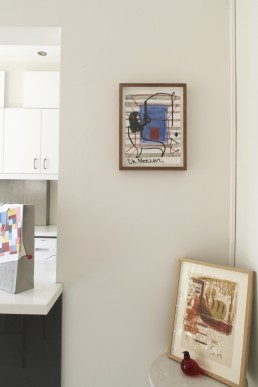
Top three pieces of advice for new collectors
1. Aesthetical satisfaction should be the goal
2. Support your locals
3. Prints are interesting for shorter amount of time than originals
Top three art destinations
1. Oslo, really!
2. Henie Onstad kunstsenter (Høvik)
3. Louisiana Museum of Modern Art (Denmark)
Three inspiring artists to watch
1. Bjarne Melgaard, sorry but not sorry
2. Ida Ekblad
3. Sverre Malling
Get your free copy of Artland Magazine
More than 60 pages interviews with insightful collectors.